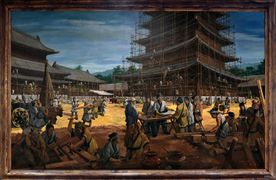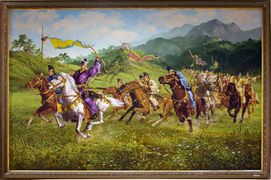2018 GGHS Team 3
목차
Team Members
| Team Position | Name (English) | Name (Korean) | Student ID | Wiki ID |
|---|---|---|---|---|
| Teacher | Anand | 아난드 | N/A | N/A |
| Leader | Moon Ji Won | 문지원 | 20104 | 3문지원 |
| Vice-Leader | Lee Seung A | 이승아 | 20715 | 3이승아 |
| Member | Soon Soo Hyeon | 순수현 | 20306 | Soohyeonsoon |
| Member | Oh Ji An | 오지안 | 20110 | 3오지안 |
| Member | Kim Ba Da | 김바다 | 10722 | 김바다 |
| Member | Han Yeo Won | 한여원 | 10720 | dff |
| Member | An Yeon Hwa | 안연화 | 10510 | 3안연화 |
Introduction
This year since May 19th, demonstrations have continued at Hyehwa Station. The protest, according to the organizers there were around 12,000 people participated in the first demonstration, 22,000 people participated in the second demonstration, and around 60,000 people participated in the third demonstration, which was not a problem for the demonstrators. These protest were beyond simple demonstration and kind of shocking. In this protest people shouted the slogan for “The advancement of women's right” based on feminism, which is emerging in Korean Society. Various media as well as SNS are promoting the demonstration and also sharing their opinion about it. This proves that Korean society is dealing with the women’s right very seriously.
In the history of Korea, women suffered physical and mental oppression for a long period of time, until we accepted this as a human rights abuse. What do you think about the condition women during Goryeo Dynasty? This year , on 1100th anniversary of Goryeo Dynasty, we need to think about the women who lived during Goryeo dynasty. Now we can’t help them but at least think about their condition during Goryeo period.
This study will analyze and contrast the life of women in Goryeo Dynasty, Joseon Dynasty which means a complete decline of women’s status and Modern Society by showing the lives of them. Through this study, we would like to send a small message that could help to solve the problems of our society and urge us to solve them.
Body
The Status of Women in the Koryo Dynasty
1) Women's status during the Goryeo Dynasty
During the Goryeo Dynasty, women's social advancement was not the same as men's. However, the status of women between social and family members was relatively equal compared to that of the Joseon Dynasty. We explored the social characteristics of women in the Goryeo Dynasty.
During the Goryeo Dynasty, Women’s remarriage and divorce were free. As Goryeo had no social antipathy to remarriage, it was possible to remarry if conditions were okay. According to some historical record the queen during Goryeo dynasty married again, which was common during that time. And there was no idea that Goryeo should have continue a family dynasty or exist a son preference. Therefore, if families of Goryeo had no children, they were able to go back to their home and make a new life after the divorce.
The sons and daughters were given equal portions of their wealth, and the ancestral memorial services were equally divided. As she inherited her property without distinction of sex, she was also given a duty. During the Goryeo Dynasty, daughters were able to inherit equally as their sons because they were the main masters of their duties. The right to inherit an equal property was accompanied by the obligation to perform ancestral rites equally. This is called " Yoon Haeng " the chinese character Yoon means " wheel " and " Yoon Haeng " means " Do thing by turns. " This means that the person who performed ancestral rites is not responsible for them, but that they are held in turn by their brothers and sisters.
The woman possessed her property independently. With the inheritance of children, women were able to own a large amount of property and remain their property after the marriage ended.
Women could have been head of family, and the family registry could have been listed in chronological order without discriminating between children. This means that women can exercise property rights or inheritance rights. According to this fact, the Goryeo Dynasty is referred to as a bilateral pro-communist society, which puts a similar weight on the blood line on the mother side, unlike the Joseon Dynasty, where only the blood line was emphasized.
During the Goryeo Dynasty, daughters and sons were given almost equal opportunities in the inheritance of status. If their ancestors did not pass on much property, they could increase their wealth by as much as possible while serving in the government, which would have made them more important to them. ' In pre-modern society women were not allowed to be officials, so naturally the inheritance of a daughter's status was given to a man through her. The target at this time was none other than her husband or son. In other words, in Goryeo, a system was in place to allow the sons and grandchildren to enter government service on the basis of their ancestors ' virtues, while those who could not only benefit from the books were in high order. Back then, the benefits of the school were not only for the male to male family but also for the daughter to daughter family. In other words, the inheritance of status shows that men and women were treated almost equally.
Monogamy was common. The time when Goryeo was subjugated in Yuan Dynasty to claim monogamy, and when Yuan Dynasty did not ask for a daughter from Goryeo, not only the daughter of the royal family, but also the godless.
The man lived in his in-laws for a long time after his marriage. When a woman enters her husband's residential area, women are subject to male authority because she is absorbed into the husband's family. On the other hand, a family system in which a husband is married is a phenomenon that occurs in a society with maternal relatives. Therefore, if you look at the rate of residence, you can estimate to some extent the status of women in the family and society.
An Example of a Woman's Status in the Goryeo Dynasty - Buddhist monk Jin-hye : The ambassador she received is a higher level of succession than the " Daeduk, " which male monks received after they passed the bar during the Goryeo Dynasty. Although there is a limit to what was given after death, it is almost the only case in which she received the position of ambassador as a female monk through 500 years of Goryeo. In this case, the ambassador believes that she demonstrated the status of women in Buddhism during the Goryeo Dynasty. - Thorn of Goryeo Dynasty Yeom Kyung-ae was buried next to her father after her death, and her daughter returned to her home when her husband passed away.
The status of women in the Joseon Dynasty
The status of women in the Modern Society
Comparion of Women’s Status among different time period
Conclusion
We looked at the lives of women in our history through this study. Furthermore, by analyzing the differences and similarities between the two, we had a brief overview of the history of women's human rights. This activity provided an opportunity to think deeply about human rights, thus human rights, as well as women's rights.
Through this study, we will be more concerned about human rights, and by extension, the authors of the study have come to realize the link between human ethics and history, to integrate it with reality, and thus the violation of women’s human rights that occurs around us even the rights of living creatures in the world.




